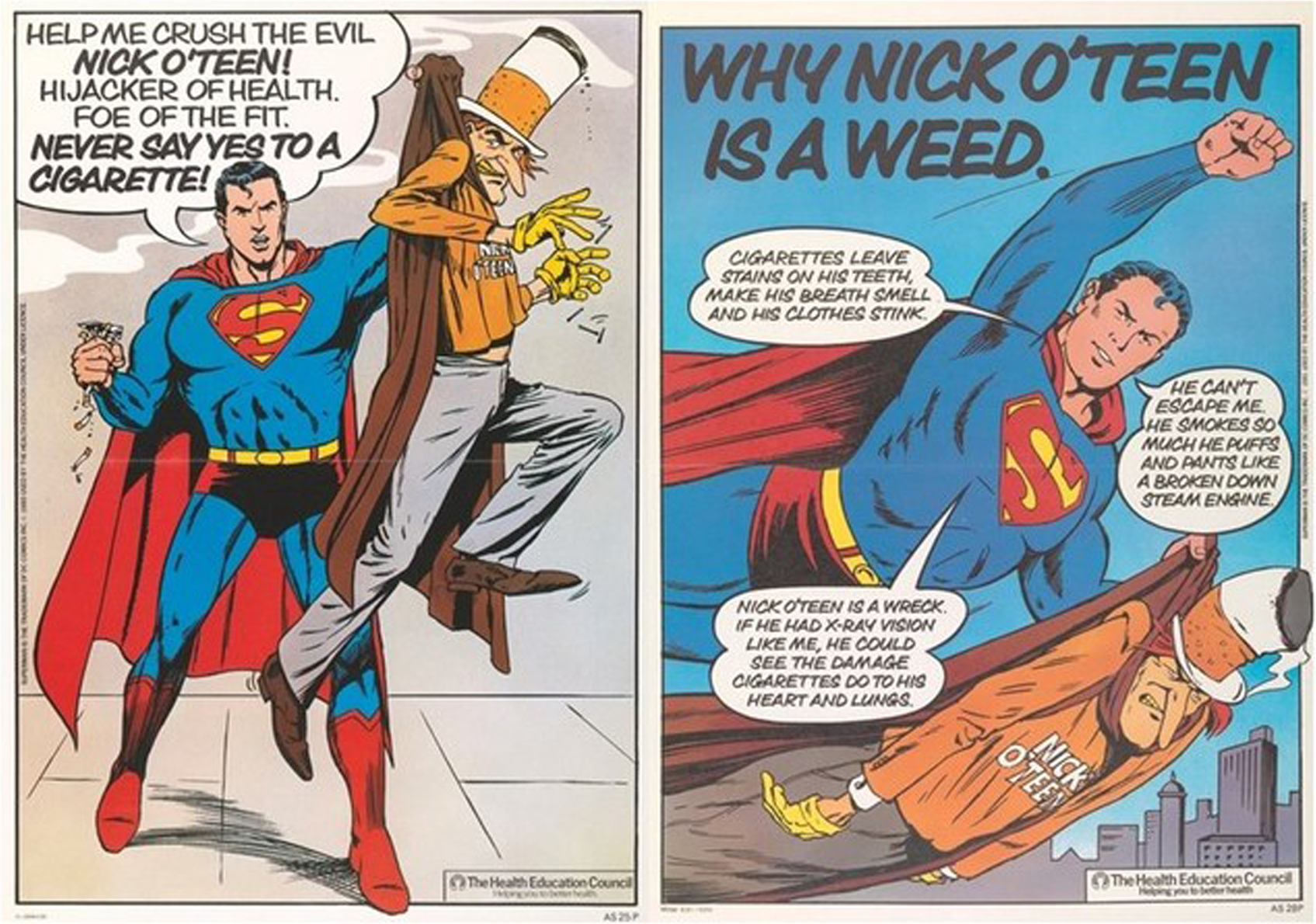Whenever the claim of a ‘golden age in the mid-20th century is presented, there are many go-to examples to disprove this: civil rights conflicts, the threat of nuclear warfare, and treatment of women as inferiors all common but another more unorthodox instance is the sheer positivity about cigarettes. Tobacco was first brought to Europe by Christopher Colombus in the late 15th century, with Francis Drake noting in 1610 about the addictive state of tobacco, and in 1950 having the first published report of tobacco causing lung cancer. These people did not let ethics or facts get in their way, as they were happy to create and begin Advertising Smoking to Children
Television
By the 1950s, half of the world’s population were smokers, with the UK seeing 80% of men smoking. For a big business to sustain this, the area to tap into is Advertising Smoking to Children, the next generation;
![Forget Kids' Vitamins And Cereal – The Flintstones Had Their Own Cigarette Ad [VIDEO]](https://allthatsinteresting.com/wordpress/wp-content/uploads/2018/02/flintstones-smoking-ad.png)
To start with, let’s discuss the promotion of smoking on children’s TV. Most infamously, early series of The Flintstones were advertised by Winston cigarettes, so much so that some episodes ended with the duo lighting a cig, whilst Wilma was doing some housewife chores. As Fred points out they are “the one filtered cigarette that delivers flavour 20 times a pack,” and that “Winston’s tastes good like a cigarette should.”

Advertising Smoking to Children
An early marketing example of trying to reach out to children smokers includes Willy The Penguin, who was created by the Kool brand in 1934. This penguin dressed up under different professions including a doctor, which makes sense considering how at the time doctor’s often promoted smoking – more so than many other professions. Batman co-creator Bob Kane insists this comic strip penguin inspired the creation of The Penguin supervillain.
Elsewhere, Lucky Strikes used Santa further allegedly direct smoking to children, with a 1936 advert seeing Kris Kringle commenting that “Luckies are easy on my throat.” Chesterfield cigarettes had Santa stating: “Light up and share the very best of Christmas…Chesterfields have all the benefits of smoking.”

Marlboro had perhaps some of the most disturbing advertisements about children smoking. Indeed, babies were used in adverts, sharing posters with lines such as: “never feel over-smoked”, “My dad smokes Marlboro…he knows it’s a good thing” and the slogan “That’s the miracle of Marlboro.” Philip Morris International also paid $40,000 (now $140,000) to splash their brand advertising all over Superman II, which would have been watched by millions of children. Superwoman was presented as a relentless chain-smoker in the film, with up to 20 significant sightings of the Marlboro branding, leading to a congressional investigation.
The most successful marketing character was Joe Camel. Presented as a suave and cool anthropomorphised camel, Joe was created in 1987, 75 years after the Camel brand was created – then using a realistic camel image. Joe would wear sunglasses and leather jackets whilst riding around in cool convertibles and picking up the ladies.

Luckily, Joe never appeared on TV, banned by the Public Health Cigarette Smoking Act of 1970. Yet that did not make his impact any less disastrous to children’s health. Whilst Executive Vice-President of R.J. Reynolds Tom C. Griscom claimed that “There is no evidence that the Camel campaign has caused more youth to begin smoking,” the statistics seem to disagree.
Camel accounted for 32.8% of all cigarettes bought by minors. Yes, before Joe Camel, children brought in $6 million for the company but by 1992, this figure had ballooned to $476 million. In a 1991 study of 229 children, 91% of six-year-olds identified Joe Camel as synonymous with cigarettes, in the same way, Mickey Mouse was associated with Disney. As the Federal Trade Commission’s (FTC’s) Jodie Bernstein states:
“After the initiation of the Joe Camel campaign, the percentage of smokers under the age of 18 who smoked Camel cigarettes became larger than the percentage of all adult smokers [using Camels].”
Even then-US president Bill Clinton commented on the situation, explaining that “We must put tobacco ads like Joe Camel out of children’s reach.”

Moving on, the Lorillard company allegedly gave away free cigarettes at schools in which students were still in the single digits. Marie Evans was first supplied at age nine with the cancer sticks for free and would go on to die of lung cancer four decades later after early exposure caused addiction. The son of Evans sued after his mother’s death and after a years-long court battle earned $70 million.
Brands even created flavours for children, including cereal flavours and those which would attract a younger generation such as vanilla, cherry, chocolate, and blueberry.
On a final point, these companies did not publicly announce that ETS (secondhand smoke) was harmful to others. This is although it was reportedly mentioned in private and internal memos years before being exposed to the public, putting children’s lives in danger.
Punishments
In 1988, the Tobacco Master Settlement Agreement took place in which the four largest tobacco companies – the then-Philip Morris International, R.J. Reynolds, Brown & Williamson, and Lorillard – pay $206 billion (yes, BILLION) to pay smoking-related medical costs across 46 US states. This amount of cash is what more than 150 countries in the world have in their national Gross Domestic Product (GDP).
Groups were also found in court to lie about the non-harmful effects of smoking, leading to a forced admission statement one of which read: “Cigarette companies intentionally designed cigarettes with enough nicotine to create and sustain addiction.”
It is also said by some that cleaner alternatives were created but ditched as they may hinder public perception of cigarettes and therefore decrease sales.

The 1980s saw anti-smoking campaigns, most memorable Superman beating up the villainous Nick O’Teen. ID is now required in the purchase of cigarettes so minors have less chance of obtaining them as well as images on the packaging showing the symptoms of repeated smoking, with graphic images dissuading wannabe smokers.
In 2009, it was announced that the US Food and Drug Administration (FDA) banned candy and fruit-flavoured tobacco cigarettes whilst in April 2021, Joe Biden announced the FDA will propose rules to remove menthol cigarettes and flavoured cigars from the marketplace.
Limited Deterrents?
The factors above do pose opposition to big-scale smoking corporations but these may not be as fatal to the industry as perhaps some think they should be.
The $206 billion fine is not insignificant but will not make a huge dent long-term for the brands after payment, plus the current raking-ins of the companies as well as previously-garnered cash will help put the minds of these industries at ease. Biden’s promise to remove the menthol cigarettes and flavours has not surfaced, in addition.
The rates are still high. In the UK of the three million 11-15-year-olds, 6% have already had their first cigarette. This may not sound high but is still 207,000 children. In the US, 1,6000 youths smoke their first cigarette a day and nearly 200 start smoking, whilst 90% of tobacco users under 19 have smoked, claim the Marine Corp Community Service (MCCS).
The Centers for Disease Prevention and Control (CDC) have stated that “5.6 million of today’s Americans younger than 18 will die early from a smoking-related illness” and “About 30% of teen smokers will continue smoking and die early.” It has also claimed smokers die 13-14 years younger than non-smokers, meaning about one in three smokers who retain their smoking status from their teens will die 13-14 years earlier.
Unbelievable Quotes From Tobacco Corporations; Advertising Smoking
- Imperial Tobacco, internal report, the 1990s: “The desire to quit seems to come earlier now than before. Attempts to quit are very painful, they thought they could quit early but they soon learned they became slaves to their cigarettes.”
- R.J. Reynolds, tobacco company chairman, 1996: “If children don’t like to be in a smoky room, they will leave. At some point, they begin to crawl.”
- Philip Morris International, internal memo, 1981: “We do realise that today’s teenager is tomorrow’s potential customer.”
- Philip Morris International, president, 1971: “Babies born from women who smoke are indeed smaller but they are just as healthy as the babies born to women who do not smoke. Some women would prefer to have smaller babies.”
- Philip Morris International, CEO, 1998: “What do you think smokers would do if they didn’t smoke? You get pleasure from it and you get some other beneficial things such as relief, maybe you’d beat your wife.”
- Tobacco Institution, Walter Merriman, 1992: “If it were legal to sell to them [children], we would be glad to, but it’s not.”
- R.J. Reynolds, executive, 1992: “We don’t smoke that shit, we just sell it. We reserve the right to vote for the young, the poor, the black, and the stupid.”
Epilogue; Advertising Smoking
In my opinion, I view these companies as gluttonous, harmful, and evil institutions that favour money over any sense of ethics or morality. Although they have moved towards healthier efforts, these are seemingly only when forced not out of the kindness of their hearts. For decades, they have allegedly made money from deception whilst also endangering the lives of many generations to gain profits. As much legislation is halting this, in my opinion, horrible industry as possible yet they continue to stride through all that is thrown against them.
There are many things we have not even mentioned here. Aside from the mention of advertising to children – we could mention the paying off of doctors, Marlboro’s conflict of interest delving into inhalers, the alleged concealing of evidence, unwanting to adapt to healthier alternatives earlier on, lack of tax-paying – and the list goes on.
These industries know they need forever fresh customers, with their products helping kill off or give lung cancer to their current customers. They know they can allegedly hook in the young with addiction, with attempts to stop cycling around back to cigarettes.
As author Fletcher Knebel has proclaimed: “Smoking is the leading cause of statistics,”, so how better than to make those statistics be targeted at those who could have healthy, happy, and lengthy lives ahead(?)
GRIFFIN KAYE.


